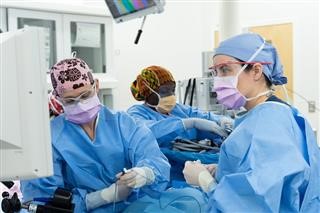The Infertility Website
Infertility Hormone Injections
You found your source for total info and resources for Infertility Hormone Injections on the Internet.
Prior to its conception, laparoscopy was a surgical approach with very few applications, mainly for purposes of diagnosis and performance of simple procedures in gynecologic applications.[citation needed] The first publication on modern diagnostic laparoscopy by Raoul Palmer appeared in 1947,[36] followed by the publication of Hans Frangenheim and Kurt Semm, who both practised CO 2 hysteroscopy from the mid-1970s.[37] In 1972, Clarke invented, published, patented, presented, and recorded on film laparoscopic surgery, with instruments marketed by the Ven Instrument Company of Buffalo, New York.[38] In 1975, Tarasconi, from the Department of Ob-Gyn of the University of Passo Fundo Medical School (Passo Fundo, RS, Brazil), started his experience with organ resection by laparoscopy (Salpingectomy), first reported in the Third AAGL Meeting, Hyatt Regency Atlanta, November 1976 and later published in The Journal of Reproductive Medicine in 1981.[39] This laparoscopic surgical procedure was the first laparoscopic organ resection reported in medical literature. There are many factors that may be causing your fertility difficulties. Large submucosal uterine fibroids may make the uterus' cavity bigger, increasing the distance the sperm has to travel. The AZFc Region of the Y Chromosome Features Massive Palindromes and Uniform Recurrent Deletions in Infertile Men. (PDF, 5 MB) Nature Genetics, 2001. WHO categorizes ovulatory disorders into three groups: group I is caused by hypothalamic pituitary failure (10%), group II results from dysfunction of hypothalamic-pituitary-ovarian axis (85%), and group III is caused by ovarian failure (5%). The progestins that can be used and the doses are as follows: Medroxyprogesterone acetate (eg, Depo-SubQ Provera 104; administer 104 mg SC q3mo or q12-14wk) Megestrol acetate (eg, Megace 20-40 mg PO qd for up to 2 months) Norethindrone acetate (eg, Aygestin 15 mg PO qd for 6-9 months) [145, 146, 147, 148, 149, 150] The androgens used are 17-ethinyl testosterone derivatives (eg, danazol 400-800 mg PO divided BID; not to exceed 9 months) [151, 152, 153] The GnRH agonists used are as follows: Leuprolide acetate (eg, Lupron 3.
Gonadotropin-releasing hormone (Gn-RH) analogs: These can help women who ovulate too early—before the lead follicle is mature—during hmG treatment. An on-line WHO infertility virtual consultation course includes a 5 module WHO evidence-based medicine course, as well as a 16 module ASRM eLearning course which reviews the evidence-base for the basic diagnosis of the infertile male and female, coupled with management and treatment. Couples will have to consider the ethical and emotional aspects of this procedure. Judaism and Repoductive Technology. (PDF, 160 KB) 2003.
Even more Info Around Femara Infertility Success Rates

A lot more Resources For Infertility Hormone Injections
Men with this type of male infertility have normal sperm in the testicles. But it may actually point to an underlying condition, such as endometriosis or pelvic inflammatory disease. If the woman is aged over 35 years, the couple may wish to see a doctor earlier, because fertility testing can take time, and female fertility starts to drop when a woman is in her 30s. Laparoscopy: A thin, flexible tube with a camera at the end is inserted into the abdomen and pelvis, allowing a doctor to look at the fallopian tubes, uterus, and ovaries. It can also help if a man has severe erectile dysfunction.
Below are Some More Resources on Infertility Treatment Percentage
38,39 Family physicians may choose to attempt ovulation induction in anovulatory women (WHO group II) with clomiphene. Advantages[edit] There are a number of advantages to the patient with laparoscopic surgery versus an open procedure.
Here are Some More Resources on Infertility Treatment Percentage
The substances are preferentially used at the beginning of the cycle. Ovulation-inducing drugs and ovarian cancer risk: results from an extended follow-up of a large United States infertility cohort. 21,22 Evaluation of Women Jump to section + The etiology of female infertility can be broken down into ovulation disorders, uterine abnormalities, tubal obstruction, and peritoneal factors. So, if you’re finding it difficult to have a baby, you’re not alone. Metformin (Glucophage) is another type of medication that may help you ovulate normally if you have insulin resistance or PCOS (polycystic ovarian syndrome). Implantation: the process when the fertilized egg attaches to the uterine wall. Results of Microsurgical Vasoepididymostomy: Role of Epididymis in Sperm Maturation. (PDF, 3 MB) Human Reproduction, 1989. Infertility and Impaired Fecundity in the United States, 1982-2010: Data from the National Survey of Family Growth. But the new standard suggests that the inability to find a suitable sexual partner could be considered an equal disability, The Daily Telegraph reports. There may be testicular malformations, hormone imbalance, or blockage of the man's duct system. Treatment Possibilities: Female Infertility Depending on the cause of infertility, there are different possibilities for treatment. With the fast progression in reproductive medicine and the experiences gained through infertility management, a wider range of treatment options have become available to infertile couples [17-19,21-26,31,36], (Appendix 4).
Previous Next
See also
Infertility Cause Thyroid
Infertility Prevalence Worldwide
Endometriosis Scarring and Infertility